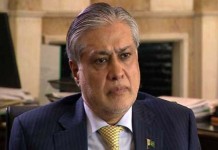QUETTA: At least 18 people were killed and 30 others injured in a suicide attack at a shrine in Balochistan’s Jhal Magsi district Thursday evening, officials said.
The explosion took place outside Dargah Pir Rakhel Shah in Fatehpur town of the district where Urs celebrations were underway, officials said, adding scores of people had gathered at the shrine to pay their respects at the time of the blast.
Thursdays are usually busy in terms of attendance at shrines as the day is considered spiritually significant.
Jhal Magsi district police officer Mohammad Iqbal confirmed that it was a suicide blast. He said a constable was killed while attempting to stop the suicide bomber from entering the shrine. “Police grabbed him and the suicide bomber detonated the explosives,” he said.
The death toll and nature of the blast was also confirmed by a district health officer.
The medical superintendent of Gandawah Hospital, Dr Rukhsana Magsi, said that 18 dead bodies were brought to the hospital. She said that 30 injured were brought to District Headquarters Hospital Gandawah of which 18 were shifted to Quetta and Larkana for medical treatment.
Initial reports suggested that the explosion took place when the dhamaal — a devotional dance performed at shrines — was being performed after Maghrib prayers. Balochistan Home Minister Sarfaraz Bugti said that if the attacker had managed to enter the shrine, the death toll would have been much higher.
To a question that whether the government was aware of looming terror threats to the shrine, Bugti said, “We are in a war zone. We [share] a porous border with Afghanistan. Keeping all these factors in mind, our security forces ensured a peaceful Moharram and they will continue to fight terrorism in Balochistan.”
Earlier, Balochistan government spokesperson Anwarul Haq Kakar said 13 people had been killed. “We have confirmed reports it was a suicide attack,” he said.
A bomb attack on the same shrine killed 35 people in 2005. On March 19, 2005, at least 35 people were killed and many injured when a suicide bomber exploded himself at the shrine. The dead had included devotees from different sects who were in attendance at the shrine.
“The suicide bomber struck outside the shrine at a time when it was packed with people, attending anniversary celebrations at the shrine,” another government official, Asad Kakar, said.
Members of both Sunni and Shia sects visit the shrine daily, with attendance climbing significantly during festivities.
Security forces reached the shrine soon after the explosion and established a cordon around it.
According to a blog maintained by the shrine’s administrators, Sufi Rakhel Shah was born in 1852 AD in the district of Mirpur, Balochistan. His father, Noor Shah, claimed descent from Hazrat Ali. His eldest brother, Sufi Abdul Nabi Shah, was a disciple of Fakir Jaanullah Shah, a devotee of Sufi Innayatullah Shah.
Rakhel Shah, who is said to have been influenced by his brother’s spiritual way of life, was for a time a disciple of Sufi Abdul Sattar of Dargah Jhoke Sharif, which is located in lower Sindh. After spending some time there, Rakhel Shah returned to Fatehpur to live a life of asceticism and charity.
This was the second deadly attack on a shrine in Pakistan in 2017. In February this year, a suicide bomber had killed more than 80 people and injured more than 250 in an attack targeting the busy Lal Shahbaz Qalandar shrine in Sehwan, Sindh.
Thursday’s attack happened hours after chief of the military’s media wing highlighted the army’s efforts in combating terrorism across the country and brought up the role of ‘non-state actors’ that the army believes are being sponsored by enemy agencies.
Sectarian and separatist violence in the province has claimed thousands of lives in Balochistan over the past decade.
Published in Daily Times, October 6th 2017.











